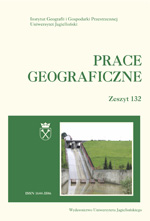Temperatury ekstremalne w Polsce w latach 1951 – 2006
Extreme temperatures in Poland 1951 – 2006
Author(s): Zuzanna Bielec-Bąkowska, Katarzyna Piotrowicz Subject(s): Cultural Essay, Political Essay, Societal Essay
Published by: Wydawnictwo Uniwersytetu Jagiellońskiego
Keywords: air temperatuire; extremely cold and hot days; Poland
Summary/Abstract: The paper identifies trends in the change in extreme air temperature characteristics, including the average, maximum and minimum temperatures, at 22 Polish weather stations during the period 1951 – 2006. The statistical analysis included the determination of ≤ 10 and ≥ 90 percentile temperatures, the number of extremely cold days ( Tmin ≤ –30 °C ), extremely hot days ( Tmax ≥ 35 °C ) and hot nights ( Tmin ≥ 20 °C ). It was found that the trends in the air temperature were not only related to changes in thermal conditions observed across Central Europe, but were often synchronised. In the long–term, there was a gradual increase in the temperatures, as was the number of extremely hot days, while the number of extremely cold days was falling. Around the year 2000, there were seasons and entire years that reached very high temperatures to the point, in some cases, of extreme values. Indeed, this was a period with the highest air temperatures since the beginning of instrument–based records. It also involved an increase in the number of extremely hot days and a decrease in the number of extremely cold days thus confirming trends observed earlier in these two types of days in Poland. A comparison of the long-term change in the maximum and minimum air temperatures reveals that their average annual values are always statistically significant, which suggests a warming of the region’s climate. The picture changes, however, when looking at seasonal and monthly values, both average and exceptionally high or low; and the change becomes less clear and mostly statistically insignificant over a large proportion of the country. This is confirmed by the results of long-term studies into the variability of extreme thermal conditions in the southeastern Polish region of Malopolska in the second half of the 20th century ( Bielec-Bąkowska and Łupikasza 2007 ). This may mean that the intensity of the climate warming observed is not high enough to be translated into a visible change in extreme conditions. The sources of variability of the thermal conditions in Poland also remain debatable. Natural factors, prominently featuring atmospheric circulation, seem highly influential, but are also strengthened by antropopressure, including the urban heat island. This latter proposition is confirmed by the fact that the temperature increase observed greatly exceeds the natural climatic variability (IPCC 2007).
Journal: Prace Geograficzne
- Issue Year: 2013
- Issue No: 132
- Page Range: 59-68
- Page Count: 40
- Language: Polish

